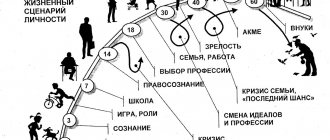Personal socialization is the process of integrating a person into the social system by mastering norms, rules, skills and knowledge that will help him function normally in society. If the behavior of animals is determined by instincts, then a person needs socialization for normal life.
In the online program “Self-Knowledge” you will be able to find out your characteristics, strengths and weaknesses and adjust the vector of your development.
Types and agents of socialization.
Socialization
is the process of an individual’s assimilation of patterns of behavior, psychological attitudes, social norms and values, knowledge, and skills that allow him to function successfully in society, beginning in infancy and ending in old age.
Types of socialization: 1. Primary socialization
. This stage covers the process of formation and development of personality, that is, the process of caring for, raising and educating children primarily in the family, carried out by those agents of socialization who are in direct and regular contact with the child in early and late childhood. During primary socialization, passive assimilation of information, skills, and ideas predominates.
2. Secondary socialization.
This stage covers the rest of the person’s “adult” life. At this stage, the development of the social environment occurs consciously, most of the information coming from outside is subjected to critical consideration. The individual makes a meaningful choice from several options.
3 Early socialization
represents a “rehearsal” for future social relations. For example, a young couple may live together before marriage in order to have an idea of what family life will be like.
4. Resocialization
is re-socialization that occurs throughout an individual's life. Resocialization is carried out by changes in the individual’s attitudes, goals, norms and values of life
5. Organizational socialization
is the process by which an individual acquires the values, abilities, norms of behavior and social outlook that are important for gaining weight in the organization and full participation in it as an employee
6. Group socialization
is socialization within a specific social group. Group socialization is the process of inculcating ideas and principles into an individual as he internalizes the basic values and symbols of the group in which he is involved.
7. Gender socialization
- this is the assimilation, internalization of social roles, differentiation of activities, statuses, rights and responsibilities of individuals depending on gender.
9 pages, 4458 words
GOALS, SUBJECT, TASKS OF THE EDUCATIONAL PROCESS, TYPES AND TYPES ...
... actions provided for by law. GOALS, SUBJECT, OBJECTIVES OF THE EDUCATIONAL PROCESS, TYPES AND TYPES OF EDUCATIONAL PROGRAMS IMPLEMENTED 2.1. The school operates in accordance with ... and the formation of the student’s personality, his inclinations, interests and abilities for social self-determination. Basic general education is the basis for obtaining secondary general...
Agents of Socialization
- these are structural groups or environments in which the most important processes of socialization take place. In all cultures, the most important agent of primary socialization for a child is the family. However, in later stages of life, many other agents of socialization come into play. Agents of secondary socialization of an individual are school, university, army, church.
Peer groups, the media, mass printed publications, and electronic communications have a great socializing effect on a person.
Features of socialization of children with disabilities
The socialization of children with disabilities - disabilities - provides for their right to diagnosis, special programs of psychocorrectional work, organizational and methodological assistance to families, differentiated and individual education. For children with special educational needs the following are created:
- Specialized preschool educational institutions, schools or correctional classes in regular schools.
- Health educational institutions of sanatorium type.
- Special correctional educational institutions.
- Educational institutions for children in need of psychological, pedagogical and medical and social assistance.
- Educational institutions of primary vocational education.
Opportunities for obtaining secondary vocational and higher vocational education are being created for children with disabilities. For this purpose, special educational institutions are created, and various forms of integration are provided for in general institutions.
Despite this, the problem of socialization of children and adolescents with disabilities continues to remain relevant. The question of their integration into the society of “healthy” peers raises a lot of controversy and discussion.
Stages of personality socialization
There are several stages of personality socialization:
Primary socialization, or adaptation stage
(from birth to adolescence, the child uncritically assimilates social experience - adapts, adapts and imitates).
Individualization stage
(adolescence and early adolescence).
During this period, there is a desire to distinguish oneself from others, and a critical attitude towards social norms of behavior appears. In adolescence, the stage of individualization, self-determination “the world and I” acts as an intermediate socialization, since the inner world of a teenager is characterized by instability. In general, adolescence is characterized as stable conceptual socialization, during which stable personality traits are developed.
Integration stage
a desire is manifested to find one’s place in society, to “fit in” with society. Integration goes well only if a person’s properties are accepted by the group, by society. If they are not accepted, then the following outcomes are possible: - maintaining one’s dissimilarity and the emergence of aggressive interactions (relationships) with people and society; - changing yourself to “become like everyone else”; - conformism, external agreement, adaptation.
Labor stage
socialization covers the entire period of a person’s maturity, his work activity, when a person reproduces social experience by influencing the environment through his activities.
Post-labor stage
socialization covers old age, when a significant contribution is made to the reproduction of social experience, to the process of transferring it to new generations.
Material Fixation Test
- 1Socialization of the individual is:
- The process by which certain social patterns are formed from birth
- The process as a result of which each individual enters society and from this changes occur, both in the person himself and in the social group
- The process by which each individual learns moral and cultural norms
- 2How many stages of personality socialization according to Erik Erikson are there?
- Five
- Seven
- Eight
- 3Who is part of the main group of people at the initial stages of socialization?
- Relatives and friends
- Friends and controls
- Schools, universities, and other large-scale enterprises
- 4What problem may an individual have when entering society?
- Ignorance of behavioral norms
- Difficulties with adaptation, problems with changing oneself
- Adaptability problems, low activity
- 5At what stage of socialization does a child begin to understand that he is a separate person?
- At the preschool stage
- At the early childhood stage
- During my school years
Question 1 of 5
Question 2 of 5
Question 3 of 5
Question 4 of 5
Question 5 of 5
Problems of personality socialization.
Every society is objectively interested in the reproduction of its value system, in its transmission from generation to generation. This is the key to the stability and sustainability of society, the spiritual unity of generations. Problems of social values thus appear as problems of coordinating the value orientations of an individual with the value system of a given society.
Changes in the starting capabilities of young people predetermined the characteristics of the social development of the younger generation in the conditions of the formation of market relations. An integrative characteristic of the social status of young people within the entire socio-demographic group allows us to highlight some features of the socialization of the younger generation of modern society. Among them:
10 pages, 4906 words
Problems of socialization of modern youth
... manifested itself in the fact that in the study of the process of socialization of new generations, the emphasis is still placed on the targeted influence on youth from institutions, on the development of methodological instructions for education... He is characterized by both the material that he learns and the origin of this material. In the personality of the philosopher there is time, its movement, its problematics, the forces of time are unusually...
— gap in the education and upbringing system;
— deformation of the principle of continuity of generations;
— increasing trends in the reproduction of the sick generation as a result of the threatening health status of young people;
- purposeful destruction of the individual, citizen, patriot.
On the part of society, social institutions have the greatest impact on the formation of value orientations of young people. So, in the 90s. There is a transformation of the family, leading to a decrease in the level of implementation of its socialization function.
There is a transformation of the socialization function of the education system, manifested in a decrease in its role in ensuring the integration of young people into society, as well as in educating the younger generation. The foundations of the educational system are also undermined by the fact that about half of all types of professions for which training is carried out in educational institutions are not required in the labor market.
The impact of telecommunications today is assessed as both negative and positive. On the one hand, the commercialization of television channels leads to the predominance on television screens of low-quality Western films, full of violence, aggression, brutality, and sex. On the other hand, the emergence of new types of television programs helps young people both in their studies and in broadening their horizons, opening up completely new horizons of knowledge. A new type of information field permeates all spheres of social life, affecting socialization processes in various institutions of socialization.
The impact of telecommunications today is assessed as both negative and positive. On the one hand, the commercialization of television channels leads to the predominance on television screens of low-quality Western films, full of violence, aggression, and cruelty. On the other hand, the emergence of new types of television programs helps young people both in their studies and in broadening their horizons, opening up completely new horizons of knowledge.
Social deviation: concept, types.
Social deviation
- social behavior that deviates from accepted, socially acceptable behavior in a particular society.
There are many types of social deviation.
Cultural and psychological deviation
(By the nature of deviations)
Cultural deviance is behavior that deviates from cultural norms. Studied by sociologists. Psychological deviation is deviations in the personal organization: psychotics, neurotics, paranoids, etc. These deviations are studied by psychologists.
Individual and group deviation
(By subject type)
Thus, there are two pure types of deviants:
1) individual deviants
deny the norms that surround them. For example, a teenager who grew up in an intelligent family and becomes a drug addict, thereby demonstrating individual deviation.
2) group deviants
are conformists within deviant groups. For example, Children raised in alcoholic families who subsequently become part of a homeless group where substance abuse is commonplace exhibit group deviance.
Primary and secondary deviation
.(By degree of significance)
Primary deviation
- this is a type of behavior that generally corresponds to cultural norms; it is a minor, tolerant, acceptable deviation.
14 pp., 6869 words
The role of gender identity in the manifestation of deviations in behavior
...success and its achievement. Following them strengthens the structural differentiation of society, which leads to conflicts and deviant behavior. S. de Grazia introduces the distinction between “simple” and “acute”... identifies three components of deviation [25, p. 121]: 1) a person who is characterized by a certain behavior; 2) norm (expectation), which is a criterion for assessing deviant behavior 3) some other person, ...
Secondary deviation
- a process during which, after the act
primary deviation, a person, under the influence of public reaction, accepts
deviant identity, that is, it is reconstructed as a person from the standpoint of that
group to which he was assigned.
Positive and negative deviation.(
By negativity)
Positive deviation
– deviations from the norms that are encouraged in a given society.
A genius, a hero, a spiritual leader are positive deviants. Although positive deviation occurs in any society, negative deviation attracts the greatest attention from sociologists .
Negative deviation
- behavior that is condemned by society and entails punishment. Criminals, drug addicts, alcoholics, prostitutes are negative deviants.
The causes of deviation in the concepts of Ch. Lombroso, H. Sheldon, Z. Freud.
The reason for deviant behavior may lie in the structural features of the human body. The most famous supporters of these ideas are C. Lombroso and W. Sheldon. The Italian doctor C. Lombroso believed that a tendency to criminal behavior can be determined by such characteristic features as a protruding lower jaw, a sparse beard and reduced sensitivity to pain.U. Sheldon believed that a certain body structure meant the presence of characteristic personality traits. An endomorph (a person of moderate obesity with a soft and somewhat rounded body) is characterized by sociability, the ability to get along with people and self-indulgence. The mesomorph (whose body is strong and slender) tends to be restless, active and not overly sensitive. An ectomorph (distinguished by the thinness and fragility of the body) is prone to introspection, endowed with increased sensitivity and nervousness. Based on studies of the behavior of two hundred young men, Sheldon concluded that mesomorphs are most prone to deviation, although they do not always become criminals. In accordance with another biological concept, men who have an additional Y chromosome are more prone to display deviation than others, but a clear cause-and-effect relationship between the presence of aberrant chromosomes and deviation has not been identified.
The psychological approach sees the cause of deviation in psychological conflicts, problems and traumas, especially those experienced by the individual in childhood. The most famous is the psychoanalytic theory of S. Freud. Deviant behavior, according to Z. Freud, arises as a result of a conflict between Ego and Id or Superego and Id. For example, crimes arise when the Superego - the individual's civilized self-control - cannot cope with the primitive, destructive, cruel impulses of the Id. Various impulses can be suppressed, thereby moving into the unconscious layers of the psyche.
Social anomie: Concepts and causes.
Anomie
- a state of society in which a significant part of its members, knowing about the existence of binding norms, treats them negatively or indifferently, a state of lawlessness.
The phenomenon of social anomie was first described by the French sociologist Emile Durkheim. Anomie
is the absence of law, organization, norms of behavior, their insufficiency. The concept of anomie characterizes a state of society in which disintegration and collapse of the system of norms that guarantee social order occur (E. Durkheim).
4 pp., 1649 words
Expressive behavior
... (hairstyle, clothing) and a low degree of variability (physiognomic components of expression). The psychology of expressive behavior deals with a wide range of means by which a person expresses himself or herself... Moreover, expressive behavior tends to become part of this condition, for example, the stupid antics of an idiot; smile and...
Social anomie indicates that norms of behavior are seriously violated and weakened. Anomie causes a psychological state of the individual that is characterized by a feeling of loss of orientation in life. The reason for anomie is the insufficient development of rules governing the relations between various social functions that are not coordinated with each other. Durkheim believed that socially deviant behavior and crime are completely normal phenomena. If there is no such behavior in society, then it is painfully controlled. When crime is eliminated, progress stops. Crime is the price to pay for social change. A society without crime is unthinkable. For crime is inevitable, ineradicable. And the reason for this is not that people are weak and evil, but that there is an infinite variety of different types of behavior in society.
67. Social conflict: concept and types.
Social conflict
- conflict, the cause of which is disagreement between social groups or individuals with differences in opinions and views, the desire to take a leading position; manifestation of people's social connections.
In the field of scientific knowledge, there is a separate science dedicated to conflicts - conflictology. A conflict is a collision of opposing goals, positions, and views of the subjects of interaction. At the same time, conflict is the most important aspect of interaction between people in society
Depending on which subjects oppose each other, social conflicts are divided into:
Personality conflict
, i.e. a conflict that occurs within a person at the level of individual consciousness.
Interpersonal conflict
, i.e. disagreements between two or more members of one group or more groups.
Intergroup conflict
, i.e. confrontation between several groups.
According to the content of the problems that caused counter-directional actions, they distinguish industrial, family, labor, economic, political, environmental, ideological, spiritual, moral, legal and other conflicts.
According to their functions, conflicts are usually divided into:
Destructive
(disintegrative) - such conflicts destabilize social systems. Internal conflict destroys group society; strikes could put thousands of people out of work and cause serious damage to industry; marital conflicts prevent the union of spouses; and, finally, a nuclear conflict threatens the destruction of all humanity.
Creating Conflicts
– can enhance group interaction. As a result of the conflict, it is possible to quickly introduce a new leader, use new policies and new norms. Conflict may be the only way out of a tense situation. If individual rights are violated in a group, generally accepted norms are violated, then often only conflict leads to achieving balance and relieving tension.
Examples of similar educational works
The role of gender identity in the manifestation of deviations in behavior
... on the following provisions: Deviant or deviant behavior is a stable behavior of an individual, deviating from the most important social norms, causing real damage to society or the individual himself, and also accompanied by his social ...
Problems of deviations in social behavior of an individual in Russian society
... behavior inconsistency between the goals put forward by society and the means of achieving them. According to cultural explanations, deviance results from conflicts between cultural norms. In society there are separate groups, norms...
The influence of socialization defects on the conflict behavior of adolescents
... Sigmund Freud, the main stages in the socialization of the individual are the stages of psychosexual development, during which the “deployment” of a person’s innate properties occurs, but in conflict with the demands of society. According to neo-Freudians, for example...
Socialization of personality. Social conflict. Age structure of society
... attitudes and beliefs, learning socially accepted norms of behavior and communication, life style options, joining groups and interacting with their members as socialization makes sense if initially the individual ...
Gender characteristics of social ideas of young people about gender-role behavior of an individual.
... gender characteristics of social ideas of young people about the sex-role behavior of an individual. A number of representatives of the scientific community have been studying social representations in domestic and foreign psychology: S. Moscovici, J. Bruner, ...
Article:
Issues of stages and phases of socialization are resolved in the socio-psychological literature ambiguously.
Based on the criterion of “attitude to work,” G. Andreeva distinguishes three stages of socialization – pre-labor, labor and post-labor (sociological approach). The pre-labor stage covers childhood, adolescence and youth and has several independent stages:
- early socialization (imitation and copying of adult behavior by children);
- play activity, when children recognize behavior as playing a role;
- group games, in which children learn to understand what a whole group of people expects from them;
- education.
The labor stage is associated with the maturity of the individual, the realization and deepening of social experience.
The specificity of the post-work stage of socialization lies in the realization of the potential of people of retirement age.
In the above periodization, the most controversial issue is precisely the third stage of socialization. A number of scientists believe that the very concept of personal socialization is incompatible with that period of an individual’s life when all his social functions are curtailed. Others, on the contrary, are convinced that the retirement period of a person’s life is the age that continues to make a certain contribution to the reproduction of social experience.
The opposite of the sociological approach is the psychoanalytic one, from the point of view of which the period of early childhood is of particular importance for the socialization of the individual. Psychoanalysis connects the stages of socialization with the manifestation of biological trains, instincts and subconscious motives of a person.
The behavioral approach to the problem of development and formation of personality in society (V. Romenets, V. Tatenko, T. Titarenko, etc.) provides for the fact that life as an act can occur provided that each of its manifestations, acts of will, experience, each opinion will be a form of implementation of the action principle.
Another approach to considering the issue of the stage of socialization - a compromise - takes into account both sociological and psychoanalytic views.
In accordance with this approach, two stages of socialization are distinguished:
- primary (it covers two stages: from birth to the beginning of education, from the beginning of schooling to the beginning of social maturity and choice of profession)
- secondary (learning of social roles by an adult in the process of work, cognition and communication).
A person who was born is not able to exist independently in society and interact with the social environment without the help and care of an adult. The life tasks of a newborn are to move from the psychobiological to the psychosocial level of functioning and begin an “actual odyssey” of self-affirmation as a person.
Consequently, an act from birth turns into an act of self-affirmation with the help of adults, who must build their counter activity as an act, create an act environment.
The act of self-affirmation covers the ages of childhood, adolescence and youth. The stage of development after birth is characterized by the child’s great activity in identifying his potential in mastering the qualities of a psycho-social being. Preschool childhood is many times faster in terms of socialization than all subsequent periods of ontogenesis.
From the very beginning, the child asserts his absolute psychosocial competence. The preschooler does not want to play, but to transform the situation according to his imagination; the younger schoolchild psychologically gravitates not towards learning, but towards acting on the basis of voluntariness, being a conscious fulfiller of his desires; the teenager does not want to communicate, but to feel like a subject of decision making; The young man considers it most important for himself to confront his environment in his views on the ideals of life and thereby assert himself. So, the essence of this act is to proactively, through creative confrontation with the environment, establish oneself in the status of a person.
A person answers to himself the question “who I am”, “what I want and can”. Finding answers requires emotional, volitional and intellectual expenditure, one’s own initiative, activity, stability, etc. The act of self-determination has the goal of reaching the definition of oneself as a being, is doomed to an act of truth, beauty and goodness, to an act of love, it gravitates to commit, cannot help but commit.
This is a period of testing for behavioral maturity. The act of self-liberation involves a reflexive orientation in the current situation, clarification of its prerequisites and prediction of its further development from the point of view of acceptability or unacceptability for the implementation of one’s plans.
Socialization occurs under the influence of various influences and means that originate from the macro- or micro-environment. If we are talking about the purposeful influence that society exerts on the formation of personality, then these are agents of socialization.
They operate at the macro level through the media (television, radio, computer, periodicals), culture, art, etc. They influence the formation of the “I-concept”, the formation of beliefs, ideas, and value orientations of the individual. The current stage is characterized by the actualization of clarification of the main determinants and patterns of this impact at each of the age periods of the individual’s development.
Psychological influences, or the means by which a person’s socio-psychological reflection of the realities of social life is carried out, and therefore the transition of external influences of the social environment into internal regulators of an individual’s behavior, are called socio-psychological mechanisms. In other words, this is the process of combining factors characterizing the conditions of society with personality characteristics in the socio-psychological reflection of a person.
There is no systematic analysis and clear classification of socio-psychological mechanisms of socialization in psychological science. Some scientists include imitation, suggestion, persuasion, and infection as mechanisms of socialization. Others are social facilitation, conformism, compliance with norms. The third is the assimilation of standards of behavior, acceptance of group norms, a sense of shame, self-control, social exchange. According to G. Tarde, the mechanism of socialization covers imitation, identification, and leadership.
On the basis of “organization - disorganization,” socio-psychological mechanisms are divided into:
- purposeful (these include training, education, instruction, etc.)
- spontaneous influences (identification, imitation, prestige, authority, leadership, etc.).
The second group of mechanisms is mainly based on the effect of trust in a person (which carries out the impact), understatement of self-criticism, increased suggestion of the individual, self-doubt, etc.
On the basis of “awareness - unconsciousness” the following are distinguished:
- conscious (persuasion, group expectations, influence of authority)
- unconscious mechanisms of socialization (they manifest themselves mainly in early childhood and are expressed through phenomena such as suggestion, imitation, psychological contagion, identification).
The social environment affects the individual not only directly, through examples, behavior, considerations of individuals and groups, but also through books, mass media, laws, rules, norms, and moral values established in society.
At the same time, the social environment is also the objects of labor, culture, science, which are part of the flesh and blood of human life and are its indispensable attributes.
The various components of society are unequal and have unequal influence on the individual at different periods of his formation. On the one hand, special age periods in a person’s life play great importance here, and on the other hand, various economic, political, religious, everyday, sociocultural, socio-psychological conditions and cataclysms of society, the effect of stabilization and destructive factors in it.
Regarding changes in the human psyche, they can occur slowly and gradually, which is connected with the so-called evolutionary changes, which are characterized by quantitative, qualitative and structural transformations of the individual psyche.
However, along with such slow changes, violent, rapid and deep revolutionary transformations associated with crisis periods of development and formation of the individual are recorded.
In the social sciences, including sociology, such a shift of a person corresponds to the concept of “social transition” of an individual from one social state to another. Critical periods and social transitions are often accompanied by painful psychological restructuring, increased sensitivity to certain external influences, which leads to imbalance, the emergence of new needs, etc.
In modern psychology, there is currently no consensus on crisis periods or age-related crises. A certain part of psychologists believe that a crisis is an abnormal, painful phenomenon, the result of improper upbringing, while others see a constructive function in crises and consider them to be natural, an inevitable phenomenon that is determined by biological factors, in particular puberty.
Thus, 3. Freud emphasized that crisis is the result of disagreements between sexual development and social restrictions. K. Levin associated crisis periods in a person’s life with changes in his social status.
L. Vygotsky considered the alternation of crisis and stable periods as a law of psychological development. He noted that during critical periods a person’s constructive work does not stop, and destructive activity is carried out due to the fact that it is caused by the need to develop new properties and personality traits.
The transition to a higher age phase often causes a slowdown in the pace of personality development, which made it possible for L. Vygotsky to put forward a hypothesis about the lack of coincidence between the three components of human maturation in adolescence - sexual, general and social.
A crisis, according to T. Titarenko, is a long-term internal conflict about life in general, its meaning, main goals and ways to achieve them. And a person’s experience of a crisis is closely related to the degree of awareness of the crisis state, the level of personal maturity, and his ability to reflect. The corresponding age crisis is prepared from within, the time of its arrival is determined by how much a person has mastered everything that needed to be mastered at this age level.
G. Sheehy notes that during transitional moments in a person's lifestyle, a person undergoes changes in four dimensions: the first dimension is associated with the internal sense of oneself in relation to others; the second - with a sense of security and danger; the third is characterized by the perception of time (whether it is enough or not); the fourth - a feeling of physical decline. These sensations set the basic tone of life and push a person to certain decisions.
I. Toman, agreeing with the definition of a crisis as a state of sensory and spiritual stress, which requires a significant change in life positions within a short time, analyzes it (this concept) as a structured phenomenon: firstly, the occurrence of an event disrupts a person’s sensory and spiritual balance, secondly, the event changes the normal course of an individual’s life, thirdly, the event requires a change in life position and the ways in which a person acts in a normal situation; fourthly, the crisis requires the search for new methods of exiting an unusual situation.
Speaking about crisis and stable periods of a person’s life, one should also pay attention to the fact that the periodization of mental development primarily takes into account psychophysiological changes in the human body, and the periodization of social development is based on the characteristics of the individual’s interaction with society at different stages of his life (that is, to the extent his participation in social activities, social contacts, the nature of assimilation of social experience, reproduction of social connections). That is why the periodization of social development has slightly different age limits than the periodization of mental development.
For example, according to the periodization of mental development, senior adolescence (14-15 years) and early adolescence (16-17 years) belong to different age periods, while in the periodization of social development they are considered the only marginal (transitional) period of socialization and, through its similarity, mechanisms, institutions, methods, etc. are not considered separately.
In legal psychology, the age of 14-17 years is also not divided into separate periods, and the term “minor” is used to characterize it, i.e. such that it is affected by a certain social status of the individual, his civil rights, privileges and responsibilities.
So, the characteristics that fit into the concepts of “psychological age” and “social age” do not always coincide: our life provides many examples when an individual corresponds to his psychophysiological age, but in terms of social maturity is considered infantile.
American psychologists G. Gould, D. Levinson, D. Vaillant identified the following special periods in an individual’s life:
- 16-22 years (at this time when a person tries to prove to himself and others that he is capable of independent life; a characteristic sign of behavior at this age is the demonstration of his own independence);
- 23-28 years (this period is characterized by self-affirmation of the individual; a person develops a stable idea of the place he occupies or would like to occupy in life; this period is characterized by a sharp change in life course);
- 29-32 years (not a transitional period between two life stages, when a rather sharp reassessment of values occurs, questions arise like: “Is this how I imagined my life?”; this is an extremely difficult period, which is characterized by emotional imbalance, frequent mood swings) ;
- 33-39 years (during this period, family life loses its charm and all its strength; for the sake of compensation, people give preference to work that contributes to achieving serious results in the professional sphere; at the same time, what has been achieved seems insufficient);
- 40-42 years (this is a difficult transition period: the results achieved seem insufficient, there is a feeling that life is being wasted; such a depressive state of mind is accompanied by deterioration in health, signs of loss of youth);
- 43-50 years (new balance; at this age, most people are characterized by stability, possibly creative growth; activity, usually very productive);
- after 50 years (the period of maturity when a person has come to terms with himself; at the same time, the question of the meaning of life and its value, what has been done and what remains to be done, this is the period when a person tries to avoid any conflicts; labor productivity may be high due to work experience).
The above periodization of special periods in a person’s life deserves attention; at the same time, it does not take into account his entire life path (from birth to death), such important age periods as one, three, seven years (these are critical periods in a child’s life); 8 - 9 years (this period is characterized by creative growth); 12-15 years (this is the teenage transition period, the child is critical of himself and his environment, trying to rethink the world around him); 55-60 years (this is a critical period in the life of men and women, because at this age most of them retire, which causes an acute feeling of uselessness).
Modern domestic psychological science attaches increasing importance to the problem of helping an individual overcome crisis conditions, especially at the stage of acquiring and consolidating professional experience, which in time may coincide with the so-called crisis of the middle of a person’s life, as the transition from youth to maturity, a new stage in understanding it provides a table of contents for one’s own existence and purpose in society. In psychological science, there is no unambiguous view on the chronology of a person’s life cycle regarding the characteristics of a given period.
So, if E. Erikson attributes the midlife crisis of a person to the age of forty, and G. Sheehy - to the period between 35 and 45 years, then T. Titarenko believes that the midlife crisis occurs at the age limit of 37-40 years.
E. Erikson characterizes this period of a person’s life as generativity, i.e. At this stage, there is a struggle between the mindset for productive development and the state of stagnation. Moreover, productivity and creativity in various areas of life are closely related to caring for others.
G. Sheehy notes that this period is a state of heightened sense of time, which is “shortening”: loss of youth, fading of physical strength, change in original roles - any of these moments can cause a crisis situation.
According to T. Titarenko, midlife is a period of extraordinary growth and internal changes, which are not without reason compared to adolescence. That is why it is called the second and last chance to do your job, to become deep and more significant, because during this period, maximum expectations from society are combined with a reorganization of personality traits, consolidation of interests, goals and responsibilities.
At the same time, the person begins to ask himself the question of the purposefulness of the life he has lived, its richness, and thinks about why he did not achieve the goals he once set for himself.
K. Jung considered middle age as the time of maximum manifestation of a person’s potential and changes in his psyche, which begin faster in women than in men.
The basis of Sch. Bühler's theory of human development is intention (intention). The intentionality of a person manifests itself throughout life in a person’s choices to achieve set goals, the formation and achievement of which predetermines the main phases of the life cycle.
The first phase lasts up to fifteen years and is characterized by the absence of any goals in a person, the development of mainly the physical and mental abilities of the individual.
The second phase lasts up to twenty years and corresponds to the period of adolescence, when a person realizes his needs, abilities and interests, plans big changes related to the choice of profession, partner, and meaning of life.
The third phase lasts until forty-five years and corresponds to the maturity of a person. During this period, clear goals are set, stability is achieved at the professional level and in personal life, decisions are made to create one’s own family and have children.
The fourth phase lasts up to 65 years. During this period, a person takes stock of past activities and revises goals taking into account his professional status.
The fifth phase begins at 65-70 years old, when most people stop achieving the goals they set in their youth. At this stage, a person tries to comprehend his existence as a whole, analyze the fulfillment of planned goals, which results in a feeling of satisfaction (goals achieved) or disappointment (goals turned out to be unattainable).
A. Milts solves the issues of development and formation of the individual in society by resolving the problem of harmony and disharmony of the individual. The author considers harmony as a concept that covers the problem of coordination between nature, society and man, which provides for mutual correspondence, balance, order, proportionality of various objects and phenomena.
The concept of “disharmony” refers to a lack of coherence, the manifestation of disproportions, antagonism, chaos, loss of balance, degradation, inconsistency of objects and phenomena or their inconsistency with the existing norm, pattern, rhythm. Often this concept is combined with the characteristics of dramatic or tragic manifestations in human life.
Here the scientist rightly raises the question of whether tragedy and drama are always a destructive or devastating force, do they not contribute to the emergence of great cultural achievements and enrich the inner world of a person, and do we have the right in any situation to assert that where there is consistency, then this is good, but where there is no consistency, it is bad?
The dispute, which has been going on for thousands of years, about who is the real owner of nature, society and man - disharmony or harmony, chaos or order is not over at all.
Disharmony brings concern, anxiety, eats away, torments and gnaws at human souls, while at the same time the same disharmony gives birth to beauty. In this regard, the idea was expressed: in order to create a bright star, chaos is needed.
One cannot but agree with another statement: the formation of a new society involves a transition to a dominant harmonious combination of nature, society and man, which does not mean that the dramatic and tragic will completely disappear - they will be embodied in the great values of human culture and human relations.









